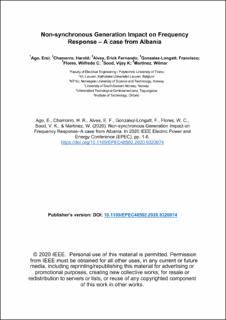| dc.contributor.author | Ago, Ersi | |
| dc.contributor.author | Chamorro, Harold | |
| dc.contributor.author | Alves, Erick Fernando | |
| dc.contributor.author | Gonzalez-Longatt, Francisco | |
| dc.contributor.author | Flores, Wilfredo C | |
| dc.contributor.author | Sood, Vijay K | |
| dc.contributor.author | Martinez, Wilmar | |
| dc.date.accessioned | 2021-08-05T09:57:08Z | |
| dc.date.available | 2021-08-05T09:57:08Z | |
| dc.date.created | 2021-01-22T12:55:44Z | |
| dc.date.issued | 2020 | |
| dc.identifier.citation | Ago, E., Chamorro, H. R., Alves, E. F., Gonzalez-Longatt, F., Flores, W. C., Sood, V. K., & Martinez, W. (2020). Non-synchronous Generation Impact on Frequency Response–A case from Albania. In 2020 IEEE Electric Power and Energy Conference (EPEC). | en_US |
| dc.identifier.isbn | 978-1-7281-6490-8 | |
| dc.identifier.uri | https://hdl.handle.net/11250/2766440 | |
| dc.description.abstract | Albanian electric power generation has been almost totally dependent on hydropower since its system inception. Within the past decade, although modest, there has been some share of power produced from Renewable Energy Sources (RES), mostly from Solar Power Plants. Going forward, the Albanian government has promoted renewable energy as an important part of its energy mix and is planning to increase the share of injected RES composed of hydro, Photovoltaic (PV) and Wind. Among these, wind energy is one of the most promising sources. This paper gives an overview of the studies performed regarding System Frequency Response (SFR) by replacing hydro inertia with non-synchronous generation. A study of frequency behavior under several penetration levels of non-synchronous generation is presented with cases which show how system frequency is affected when replacing hydro-power inertia with wind turbine converter inertia | en_US |
| dc.language.iso | eng | en_US |
| dc.relation.ispartof | Proceedings of the Electric Power and Energy Conference (EPEC), 2020 IEEE | |
| dc.relation.uri | https://ieeexplore.ieee.org/document/9320074 | |
| dc.title | Non-Synchronous Generation Impact on Frequency Response - A Case from Albania | en_US |
| dc.type | Chapter | en_US |
| dc.description.version | acceptedVersion | en_US |
| dc.rights.holder | © 2020 IEEE. | en_US |
| dc.source.journal | 2020 IEEE Electric Power and Energy Conference (EPEC) | en_US |
| dc.identifier.doi | https://doi.org/10.1109/EPEC48502.2020.9320074 | |
| dc.identifier.cristin | 1877125 | |
| cristin.ispublished | false | |
| cristin.fulltext | postprint | |
